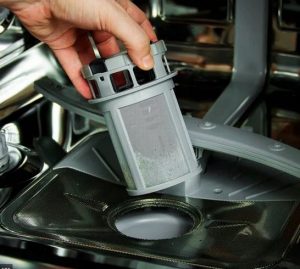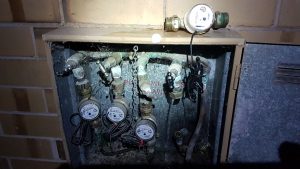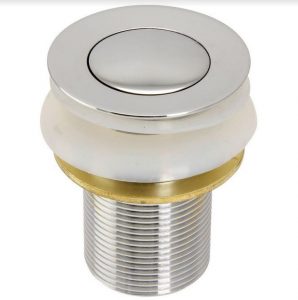Dishwasher blockage can be more than just a little frustrating. Learning how to unclog your dishwasher before calling a professional plumber will save you time and money.
With all the food particles and scraps that go through our dishwashers and down the drain pipes, it’s not surprising that you are bound to experience some sort of blockage eventually.
It is normal to have a small amount of standing water in the bottom of the dishwasher, but when you notice a puddle above the dishwasher drain and leaks onto the floor when opening the door, it may be time to check the drain line for clogs.
A few more tell-tale signs that indicate a clogged dishwasher include:
- Dirty dishes – which means the dishwasher is not cleaning dishes properly due to clogged spray arms.
- Abnormal gurgling sounds, shaking, thumping, and grinding. – this could indicate that water is trying to break through a clog in your primary or secondary sewer line.
- Water backing up in your sink – dishwashers are usually connected to your kitchen sink drainage system. If the dishwasher is running and water starts to back up to the sink, the dishwasher may be clogged. If your garbage disposal works when the dishwasher is off, it’s possible that the clog could be caused by leftover food particles caught up in the sink, which means the dishwasher isn’t the problem.
- Slow draining in your dishwasher after completing the wash cycle. – this is an early sign that you should clear out any partial clog as soon as possible before it gets worse.
While unblocking a dishwasher could be an inconvenience and a pretty gross event, it’s not a complicated fix. With a few tools, our step-by-step instructions, tips, and the energy for a DIY, you can quickly restore your dishwasher to its maximum operation levels.
When in doubt, we recommend seeking professional help rather than doing the fix wrong and completely running down your dishwasher.
Related: How To Fix Low Water Pressure Problem
How to Unclog Your Dishwasher
Once you are sure some of the signs of a clogged dishwasher above apply to yours, you can get proceed and try to fix the issue on your own.
1. Diagnose the Cause.
Start by removing all the dishes and the dishwasher racks.
Inspect your dishwasher and kitchen sink drains by running some water through each individually. Make sure there’s a clog problem before you start fixing a non-existing dishwasher problem.
2. Get Your Tools & Keep Them Close
Once you are sure of the cause of your dishwasher clog, get the right plumbing tools and get started.
Some of the tools you might need for the DIY include:
- Screwdriver (to remove the dishwasher drain grate)
- A Bucket
- Baking soda and vinegar
- Straightened Wire Hanger, Drain snake, or auger
- A shallow pan to collect off any dirt
3. Turn the dishwasher off
Unplug the dishwasher from the power source for a safe DIY project.
Check under the kitchen sink to check whether your dishwasher clothes into the electrical outlet along the back of the cabinet wall and unplug it.
If you can’t find it, or if the dishwasher doesn’t have a power cord plugged into the wall, turn off the dishwasher circuit breaker or the mains just to be sure.
Turn on the dishwasher to double-check it’s correctly disconnected from power.
4. Gain Access to Dishwasher Drains, and Clear debris.
Always remove all the food particles left on the dishwasher and any standing water by scooping it away using a cup, sponge, or towel.
Cleaning up your work area makes it easy to work around the dishwasher and also reduces the chances of spilling and falling.
Method 1: For A Blocked Drain Hose
Before turning off the power, run the garbage disposal of your dishwasher and make sure it isn’t blocked. If it is, you’ll want to deal with that first before proceeding further. If the garbage disposal is OK, the problem could be the drain hose.
- Remove the front kick plate to gain entry to the bottom of the dishwasher.
- Locate, find and unscrew the drain grate. Some models are easy to access and don’t require a screwdriver.
- Remove the drain hose using your channel-lock pliers and check for any clogs at the connection point.
- If there are none, use your homemade straightened wire or commercial de-clogger to clear debris accumulated deeper in the drain hose.
- Pour in your baking soda, vinegar, or hot water to try and see if the clog will clear before trying other drainage chemicals.
- If it works, reattach the drain grate, power on the dishwasher, and run water for about 2 minutes to check if the drainage issues have been resolved.
Alternative
- Use a straightened wire to try and loosen some of the clogs if possible. Get your garden hose, attach it to the drain hose, and gradually increase water pressure to maximum. The high water pressure can help dislodge and break down the blockage.
- Repeat step 8 above, or reduce the garden hose water pressure to medium and let the water run through for about 2-3 minutes.
Method 2: For A Clogged Dishwasher Filter Basket
Cleaning your dishwasher filter is a vital part of maintaining its efficiency.

- You will need dishwasher detergent, a clean bucket, and rubber gloves to protect your hands from dirty water and adverse reactions that could be caused by dish detergent.
- Once you dry the water from your dishwasher, pull out the dishwasher filter basket and use a fork, an old toothbrush, or your fingers to pull out any excess build-up of food particles. You can also take it out hose it down.
- Add detergent to your clean bucket and wash the filter basket using a soft bristle brush to remove extra food and residue that might be stuck.
Rinse and return the filter basket to place and check if the dishwasher is draining properly.
Method 3: For A Blocked Sprayer Arms
Make sure the dishwasher has completely finished any cleaning wash cycle before turning it off.
- Remove the bottom basket & set it aside.
- Use an adjustable wrench to unbolt and remove the center bolt nut of the spray arms. Set it aside in a tin or a safe place so as not to lose it.
- Lift and completely detach the spray arms of the center bolt.
- Clean any excessive sink waste off the arms using detergent and warm running water. You can also soak the arm in warm water with detergent and baking soda or vinegar for about an hour.
- Rinse using running water, and wipe off the spray arms using a clean cloth. If there are still particles left in the holes in the sprayer arm, use a toothpick and carefully poke them to force any clogs out.
- Rinse one final time before placing the arm back into the dishwasher.
- Replace the nut and do NOT over-tighten it.
Method 4: For A Blocked Air Gap
Many modern kitchens use an air gap that prevents water from backing up into the dishwasher. It is usually installed on the counter next to the sink faucet.
Build-up within the air gap can cause your dishwasher not to drain properly. A common sign of a blocked air gap is water pooling onto your counter.
The good news is it’s pretty easy to clean; simply take off the cap and remove any debris that you can see.
5. Know When to Contact a Plumbing Professional.
DIY plumbing projects can be fun and a great way to save a few bucks.
However, you can only go so far as unscrewing a few bolts if you have no confidence in what you are doing. In some cases, the performance issues of your dishwasher unit could be due to a more complex issue than clogging, and a simple dishwasher clog could end up costing you the whole machine.
For instance, the issue could be in the dishwasher drain pump, a broken sewer line, or a hundred other issues.
So, if your efforts have been unsuccessful, or you don’t have the right tools to fix the problem, reach out to a professional plumber.
Is Your Outside Drain Blocked? Read Through This Quick Guide here
Does Boiling Water Unclog Drains?
Hot water is a less invasive way that can help unclog partial and sometimes complete drain blockages. It’s an easy and affordable way to dissolve some clogs. However, it doesn’t always work, and you should not use it if your drainage is made of PVC pipes as they could melt or become damaged.
Steps:
- Boil water.
- Remove any water and debris from the dishwasher as you wait for the water to boil.
- Pour hot water into the drain and give it some time to cool. If it doesn’t work the first time, remove the water and try a few times again. If it still doesn’t work, you may need to opt for other methods.
Tip: Running hot water through the draining every three days or after every week can help prevent blockages. Most clogs are often caused by food debris. Always make sure to dispose of any food left on your plate and any cooking oils properly before putting the plates in the dishwasher. Leftover food fragments and oils become lodged within the dishwasher drain pipes and will eventually cause a blockage.
How do you unclog a dishwasher with baking soda?
Drain all the water in your sink and dishwasher. Create a DIY sink unclogging mixture by adding equal parts of baking soda and vinegar to a basin. Find the dishwasher basket and pour in all the mixture. Let it sit for about 15-20 minutes and rinse through using hot water.
You can also add one cup of distilled white vinegar on the top rack of the dishwasher during a regular cycle. (skip the drying cycle) The vinegar helps to strip away any greasy oil build-up. Then, sprinkle one cup of baking soda inside the dishwasher floor after the first cleaning cycle to remove lingering odors.
NOTE: Never mix vinegar and baking soda in the same cleaning cycle as the mixture could foam and create quite a mess.
Why is water left in the bottom of my dishwasher?
Water in the bottom of your dishwasher could be a result of clogs in the filter drain basket, garbage disposal, drain hose, dishwasher drain pump, or air gap. When food sediment builds up within these systems, your dishwasher won’t drain properly.
Bottom Line
A dishwasher is an essential appliance in every kitchen. It reduces the workload significantly and saves a lot of time, but like all machines, they can be affected by various aspects – one being blockages. It might seem daunting to take on such an endeavor, but it can be done with some elbow grease and patience!
Dishwasher Repair Service Near You
If you haven’t managed to fix your blocked dishwasher or have any questions about your clogged drains, or if you’d like the help of a professional plumber, contact us for any inquiry, including other plumbing works and gas fitting.
We service the South Australia area and surrounding towns around Adelaide. Reach out to us today – we’ll be happy to help!




